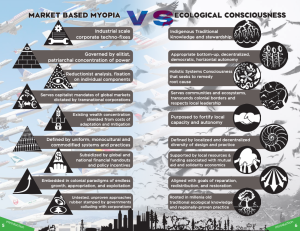1. Energy justice and energy democracy
When storms, wildfires, or power grid failures cause outages, private energy companies often get financial help, while ordinary people are left without power. The lack of local control over our energy systems makes rich executives even wealthier, while one in four households in Australia struggles to pay their energy bills. We can do things differently. The original New Deal aimed to make energy a public service but didn’t focus on racial fairness. We can learn from this and enable communities to make their own energy decisions. Together, we can rethink how we generate, use, and share clean, renewable energy (excluding nuclear power) to support a Regenerative Economy.
Read more: Energy Democracy, Climate Justice Alliance
“…an article in the Guardian highlighted the influence oil companies have had on the carbon footprint’s growing popularity. Its main message was that the idea of measuring personal carbon footprints –
in other words, calculating the emissions we’re responsible for as individuals – was originally promoted by oil giant BP to shift the burden of action (and blame) from fossil fuel companies to consumers.”
Proposed strategies are often silent on the root cause of the issue (e.g. fossil fuel industries) by framing climate change as natural and inevitable. This positions individuals as the cause and solution to the problem (Source: Petro-pedagogy info sheet – Climate Justice Union).

(Source: Petro-pedagogy)
It is not enough to only focus on personal responsibility to reduce energy use and rely mostly on technological solutions for climate change. These approaches often miss the larger socio-economic imbalances and the historical roles in contributing to climate change. We need to advocate for equitable climate action that includes major systemic and structural reforms. In the realm of energy and carbon footprint, it’s crucial to address the fundamental causes of climate change and understand the unequal impact on historically marginalised groups. Climate justice in this area demands a comprehensive transformation of our social, economic, and political frameworks, ensuring a just distribution of responsibilities and advantages. If we don’t tackle these systemic challenges, relying solely on technology and individual actions could maintain existing disparities and not lead to sustainable, fair outcomes for everyone.
Read more:
Big Oil coined ‘carbon footprints’ to blame us for their greed. Keep them on the hook (The Guardian)
2. Community-owned clean energy
Renewable, clean and affordable energy should be available to all. A fair transition to renewable energy with options for community ownership and self-determination is a valuable strategy to reduce CO2 emissions, redistribute access to and benefits from clean energy, and help shift unjust power relations. Learn about Community Energy Planning and determine opportunities to initiate a Community Energy Plan on the First Nations Clean Energy website.
Case study:
Latino Climate Justice Framework (case study)
In this framework, a Path to Energy, Environmental and Economic Justice is put forward. The proposed solutions are described with the following steps:
Invest with justice in clean energy
- Support weatherisation and energy efficiency measures to reduce energy costs, decrease reliance on fossil fuels, and enhance community resilience.
- Attain a climate-resilient, collectively managed grid infrastructure to guarantee dependable and inclusive energy access for everyone.
- Implement policy frameworks such as the Public Power Resolution, which recognises electricity as a fundamental right and public asset, aiming to establish a transparent, equitable, and fully renewable public power system.
Accelerate the transition to renewable energy (i.e., wind, solar, geothermal and small-scale hydropower):
- Implement a national Renewable Energy Standard (RES) to achieve 100% renewable, pollution-free electricity by 2035, excluding ineffective solutions like forest biomass, CCS, trash incineration, chemical recycling, and gasification.
- Expand access to renewable energy through community-based projects, including microgrids, demand response incentives, rooftop and community solar programs, along with battery storage, energy efficiency options, and comprehensive electric vehicle charging networks.
- Ensure affordability of clean energy for low- and moderate-income (LMI) communities to prioritise those most in need.
- Provide appliance efficiency rebate programs at the point of purchase rather than during tax filing for greater accessibility.
Advancing economic equity and opportunity
- Develop a diverse renewable energy workforce.
- Address discriminatory barriers to education and employment for Latino/a/x individuals and establish targeted pathways to clean, sustainable careers.
- Increase federal funding for accessible clean energy employment opportunities for Latino/a/x workers.
- Create tailored education, training, and job programs for Latino/a/x workers in emerging sectors.
- Promote clean energy jobs within Latino/a/x communities, offering fair wages and benefits.
- Establish comprehensive support systems for Latino/a/x communities during job transitions, including worker retraining programs, childcare, healthcare coverage, and opportunities for sustainable careers.
- Enhance worker safety regulations and remove legal obstacles to unionisation.
Visit action networks and organisations to find out more and contribute:
Go beyond gas – WA Working together on climate action
Climate Council – Ending fossil fuel greenwashing
Greenpeace – 8 reasons why we need to phase out the fossil fuel industry
First Nations Clean Energy Network provides an overview of actions, policy opportunities and advocacy.
Learn more:
Resist False Solutions to Climate Change (Climate False Solutions)
Captured State: The influence of the gas lobby on Western Australia (Report by 350 Perth)

(Source: Resist False Solutions to Climate Change, Climate False Solutions)
3. Take action to drive change
Transformational climate justice is indispensable in diminishing climate change as it not only addresses historical environmental injustices but also tackles the inherent power imbalances perpetuated by colonialism and capitalism. This facilitates a crucial shift towards equitable resource distribution and sustainable practices for a more just and resilient future. For example, Original Power is taking action to diversify its power sources and empower the communities.
Community organisations can help drive change and advocate for the transition from fossil fuels to renewable energy by fostering grassroots movements and engaging local communities, community organisations can raise consciousness about the environmental and health impacts of fossil fuel use. By joining campaigns, they can demand sustainable energy solutions. Community organisations can collaborate with policymakers, businesses, and other stakeholders to push for renewable energy policies and investments. Organising events, workshops, and initiatives promoting clean energy alternatives can help build a strong collective voice that urges governments and industries to take on accountability and prioritise sustainable solutions. Participating in holding fossil fuel industries accountable is vital to advancing climate justice.
4. Reduce organisational energy use and transition to renewable energy (Section for CSOs with assets)
Step 1: Create an energy transition and reduction team
Involve team members, organise meetings, familiarise yourself with energy reduction options and undertake the following steps collectively.
Step 2: Conduct an energy audit and assess your energy footprint.
To better manage your energy consumption, start by checking your organisation’s current energy usage. An energy audit provides clarification of energy utilisation and identifies areas of inefficiency where energy is wasted. Organisations can either use self-check tools or contract an official energy auditor:
Energy self-check tools:
- Energy audit toolkit on office equipment.
- Self-Check Tool (Only for Lighting)
Energy audit providers:
- Energy Audit Providers
- Reviewing and tracking your energy bills can help to identify areas of overconsumption. To understand more about WA energy policies, visit Energy Policy WA.
Step 3: Develop and integrate an energy transition and reduction action plan
Based on the results of audits and self-checks, the energy transition and reduction team can create an Energy Reduction Plan. Energy Reduction Action Plans can include:
- prioritising the energy-reducing actions in the short, medium and long term,
- setting the target of energy transition and reduction,
- planning the transition to renewable energy,
- calculating expenses and budget for energy transition and reduction,
- develop relevant policies and procedures,
- establish a monitoring and evaluation plan.
Climate Active Carbon Neutral this resources helps to provide steps for organisations to become carbon neutral.
Energy Action provides an overview of the challenges and benefits of transitioning to renewable energy.
Energycut provides a free ebook (pdf) with detailed information on how to reduce energy for businesses.
Step 4: Develop and implement energy transition and reduction policies
Develop and implement an Organisational Energy Reduction Policy and relevant procedures.
Step 6: Budget, invest and transition to renewable energy
Renewable energy is energy that comes from resources that do not run. Renewable energy can be cost-efficient, environment-friendly, and sustainable. Find out more about renewable energy on the Australian Renewable Energy Website.
| Budget
Contact renewable energy providers to learn more about available options and related costs. |
Invest
Organisations can contact CEFC to discuss clean energy investments. The WA government offers the Distributed Energy Buyback Scheme (DEBS) to support eligible customers with the transition to renewables. |
Transition
Transitioning to renewable energy will offer organisations cost-effective, environmentally friendly, long-term sustainable energy sources. |
Budget
Energy.gov.au provides information on Australia’s renewable energy options. To adopt renewable energy technology, the Clean Energy Council provides guidelines and detailed information on solar energy, solar storage solutions and installing Solar PV(pdf).
Invest
Clean Energy Finance Corporation (CEFC) is a specialist investor for small and large-scale clean energy projects, including flexible debt and equity finance, or a combination of both, tailored to individual projects. The WA Government offers the Distributed Energy Buyback Scheme (DEBS) for eligible customers (including not-for-profit organisations), which may help reduce costs. Canstar Blue lists Solar Rebates in each state and territory, and Energy gov.au offers a list of national governmental grants.
Transition
| Property owner | Property leaser |
| Plan and budget for and install solar panels.
Review the Power Purchase Agreement (PPA) options if you do not have the financial resources. Under a PPA, the electricity provider instals and maintains the solar panels on the property owner’s premises. In return, the property owner agrees to purchase the electricity generated by the solar panels from the electricity provider at a predetermined rate for a fixed term, typically between 10 and 25 years. |
For organisations who are leasing the property, they could establish a ‘Green Lease Schedule’ with the property owner.
The Green Lease Schedule is a formal commitment between tenants and building owners, setting a minimum ongoing operational building energy performance standard. Talk to the property owner to discuss your options. |
Step 5: Implement energy-efficient practices and procedures
Organisations can reduce their energy consumption by making some changes in practice, procedures and routines.
Energy-efficient practices include:
- reducing consumption,
- integrating renewable energy sources,
- upgrading to energy-efficient equipment,
- implementing smart controls.
Energy Rating and Energy Star provide information about appliances with energy ratings, including understanding energy ratings, calculations, and product databases.
Office Energy Checklist offers a simple checklist that could be used to save energy at the office.
Sustainability Victoria provides information on how to reduce the consumption of lighting.
Step 7: Get your employees and community involved
For organisations to achieve energy efficiency, involving the team and community is essential. Listen to their concerns and ideas to then implement collectively defined energy-saving plans and practices. Promote climate justice values. Enable energy reduction knowledge and daily saving practice. Energy.gov.au offers a guide to involve your team and practical office work. (Em)Powering First Nations jobs in clean energy by increasing access to training and offering career paths.
Step 8: Regularly monitor, review, evaluate and improve
The energy reduction team can use Energy Measuring Devices to track energy usage. The team can continue with regular assessments through energy audits, review energy consumption, and continuously improve where possible.
5. Quick Tips
Reducing energy consumption in the workplace
- Engage in Green Energy Advocacy and Campaign
- Engage in Community Owned Energy Advocacy and Campaigns
- Ensure renewable energy for any housing and accommodation that are part of your services
- Reduce overall consumption
- Switch off appliances at the end of the day
- Ensure photocopiers, printers, and computers are in ‘power save’ mode
- Switch off lights in unoccupied rooms
- Utilise natural light from windows and skylights
- Let fresh air flow
- Switch to energy-efficient light bulbs (e.g., LED bulbs, that save up to 80% energy)
- Keep the internal temperature of heating set to between 18 °C to 20°C
- Develop a culture where staff dress to suit indoor and outdoor climates (e.g. layers to accommodate heat and cold) instead of relying solely on air
- Close windows and doors when using aircon/heater
- Maintain an air conditioning/heating system regularly
- Check window seals and gaps between the door
- Use fans rather than A/C
- Use temperature-monitoring apps
- Use an energy tracking device to understand energy usage
- Upgrade to energy-efficient appliances
- Budget for and transition to renewable energy
Read more
Support and Participate in Community Owned Renewable Energy Projects
First Nations Clean Energy, this resource provides a list of funding opportunities.
Manage your power usage
Government of Western Australia Energy Policy WA, this Information sheet provides details on how to manage power usage in small businesses.
Manage your environmental impact
Business.gov.au, this web page of the Australian government on Business, provides additional details on how to ‘Manage your environmental impact’. It includes a guide to environmental management, links to each state and territory government’s requirements, and search links to environmental grants and awards.
Accelerating businesses to net zero
City Switch, the program City Switch helps businesses around Australia achieve net zero. This website offers a wide range of resources on improving sustainability for businesses. The benefits of joining City Switch include guidance, free online resources, national lunch and learnings, financial assistance, etc.
Environmental Sustainability Pack
Department of Local Government, Sport and Cultural Industries, this webpage provides resources, tools, policy examples and sustainability action plans for community organisations to help them understand, manage and reduce their environmental impact.
Switch to low-energy equipment
Energy Star, Energy Star is a label that helps rate the energy efficiency of electric equipment. You can learn about your current equipment and get guidance on buying new energy-efficient equipment.
Invest in options to store/sell excess energy.
Energy Matters, this article provides information about Peer-to-Peer Solar energy trading and its environmental and financial benefits.
Monitor energy use
Government of Western Australia – Energy Monitoring and Accessing Energy Data; Government of Western Australia – Access your Energy Data, those resources provide information on how to access and monitor your energy use in Western Australia.
Develop and Implement Policies
Sustainable Procurement Policy Example
Department of Local Government, Sport and Cultural Industries, this resource provides tools, such as policy examples and sustainability action plans for community organisations to help them understand, manage and reduce their environmental impact.
Understand False Solutions to Climate Change
HOODWINKED IN THE HOTHOUSE Resist False Solutions to Climate Change, this resource provides an extensive overview of false solutions to the climate crisis and suggests what real solutions should look like.
Audit Resources
Energy audit toolkit on office equipment (City Switch).

